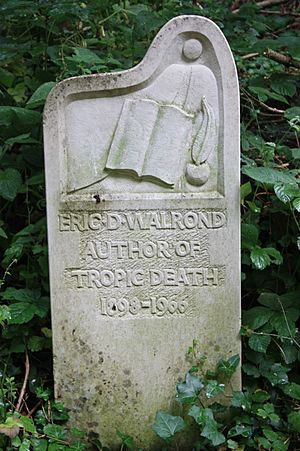Eric D. Walrond facts for kids
Quick facts for kids
Eric Derwent Walrond
|
|
|---|---|
 |
|
| Born | 18 December 1898 Georgetown, British Guiana |
| Died | 8 August 1966 London, United Kingdom |
| Resting place | Abney Park Cemetery, London |
| Occupation | Writer |
| Citizenship | British subject |
| Alma mater | Columbia University |
| Literary movement | Harlem Renaissance |
Eric Derwent Walrond (born December 18, 1898 – died August 8, 1966) was an important writer and journalist. He was part of the Harlem Renaissance movement. Eric was born in Georgetown, which was then called British Guiana. His mother was from Barbados, and his father was from Guyana.
Walrond traveled a lot during his life. He lived in Barbados, then Panama, New York City, and finally England. He made a lasting mark on literature. His most famous book is Tropic Death, published in 1926. This book is still available today and is considered a classic. It contains 10 short stories. Walrond's writing style was often described as "impressionistic." He used short sentences to create a strong feeling. Many of his characters speak in different dialects. This showed the many different people from the Caribbean region.
Growing Up and School
Eric Walrond was born in Georgetown, British Guiana. When he was eight, his father left. Eric and his mother, Ruth, moved to Barbados to live with relatives. There, he went to St. Stephen's Boys' School. Later, they moved to Panama. This was when the Panama Canal was being built.
In Panama, Walrond finished his school education. He became very good at both Spanish and English. He trained to be a secretary and a stenographer. He worked as a clerk for the Health Department of the Canal Commission. He also worked as a reporter for the Panama Star-Herald newspaper. In 1918, he moved to New York. He studied at Columbia University there.
A Writer of the Harlem Renaissance
In New York, Walrond first worked as a hospital secretary, porter, and stenographer. In 1921, he won a prize for his story "A Senator's Memoirs." This story was about a united Africa. From 1921 to 1923, Walrond was an editor. He also co-owned an African-American newspaper called the Brooklyn and Long Island Informer.
He then became an associate editor for Negro World from 1923 to 1925. This was the newspaper for Marcus Garvey's Universal Negro Improvement Association. From 1925 to 1927, he wrote for and managed Opportunity magazine. This magazine helped Black artists and thinkers become well-known in the 1920s. He also wrote for other magazines like The Smart Set and Vanity Fair.
Walrond wrote many short stories. Some of these include "On Being Black" (1922) and "The Black City" (1924). In 1928 and 1929, Walrond received the Guggenheim Fellowship. This was a special award for his fiction writing.
Life in England
After ten years in America, Walrond moved to England. He met many English writers and artists there in the 1930s. He continued to use his editing skills sometimes. He also worked as an accountant. From 1939 to 1952, he lived in Bradford on Avon, Wiltshire. During this time, he worked at a factory.
In 1952, he went into a psychiatric hospital called Roundway Hospital. He stayed there until 1957. After leaving the hospital, he worked on a play. This play was shown at London's Royal Court Theatre.
On August 8, 1966, Eric Walrond passed away in central London. He was 67 years old. He was buried at Abney Park Cemetery in Stoke Newington. After his death, his early writings became more recognized. Books like Winds Can Wake up the Dead... were published in the 1990s.


